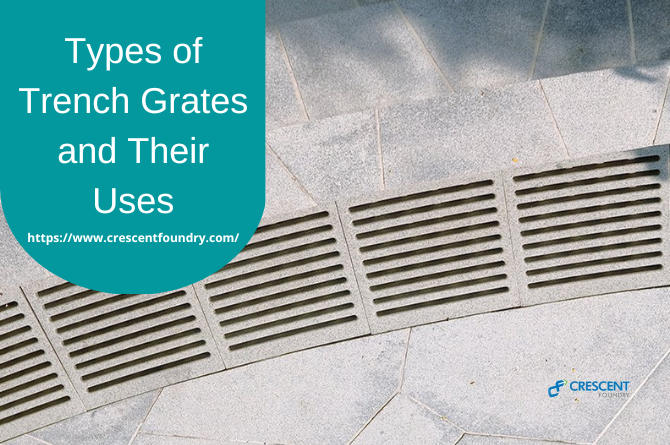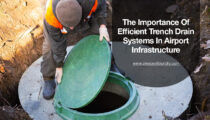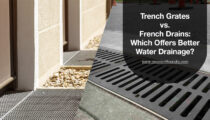Urban infrastructure is the backbone of modern cities, facilitating the…

Types of Trench Grates and Their Uses
While drainage grates are pretty much ubiquitous in the present-day society, they do not often get the attention they deserve from people. A high-quality, custom-designed trench grate system plays an important role in ensuring that drainage systems work properly – and excess water/other liquid are effectively controlled and removed. Generally used as covers or partitions, trench grates offer the required amount of access and ventilation – while maintaining the desired levels of sanitation.
Based on their material, application areas, and other key features, trench grates can be of various types. Here’s an overview of the different varieties:
Cast Iron and Ductile Iron Trench Grates
In terms of mechanical strength and durability, trench grates and frame made of cast iron or ductile iron are excellent. The material used in these grates is typically known as ‘gray iron’ – and it comes with powerful load-bearing and vibration damping capabilities. As a result, cast iron trench grates have practically no chances of getting deformed – even when subjected to heavy compression. This makes them ideal for high-traffic areas and municipal locations. Apart from the robust impact resistance, the anti-corrosion assurance and the easy availability of these trench grates are major advantages too.
Stainless Steel Trench Grates
Trench grates or trench pans made of stainless steel offer top-notch combinations of material toughness, reliability and load-bearing capacity. The high levels of chemical resistance in steel trench grates is an important factor as well. The gratings have good thermal resistance too, and can be designed to have a certain degree of aesthetic appeal. Different patterns and finishing options are made available by manufacturers, to meet the precise customer requirements. Stainless steel trench grates also ensure superior levels of cleanliness and sanitation.
Stone Trench Grate System
Used in industrial & municipal grates as well as for decorative gratings, stone trench grates typically come with rust-free assurance, high longevity, and top-notch sustainability. The inherent toughness of stone contributes to the overall strength and durability of these grates. The enhanced slip-resistance of stone trench grates maximises the safety factor. Channel gratings made of stone tend to absorb less amount of heat, and can easily withstand harsh external conditions.
Concrete Trench Grates
While concrete gratings are still commonly used, they rank behind the cast iron varieties in terms of ease of installation, usability and even performance. For starters, the volume of manual work involved in making concrete grates is comparatively high. Many foundry companies tackle this challenge by using precast trench grates – where the concrete grating is manufactured in the factory, and is brought as ready-to-install pieces. Concrete gratings can be flexible though, with things like slope, depth & width, and other select features being customisable.
Linear Trench Drain Grates
Generally manufactured with premium-quality polymer concrete, steel or structured plastic – these trench grates are rapidly growing in popularity in commercial, municipal and industrial setups. Made with precision engineering, the linear trench gratings have concrete added to them, for making the drainage system stable and mechanically resistant. In fact, the concrete casting process makes sure that these gratings have the requisite degree of rigidity, load rating and resistance properties.
Plastic Trench Grates
Ease of castability and installation, together with their lightweight nature and relatively competitive pricing are key factors behind the widespread popularity of grates and frame systems manufactured with industry-grade plastic. However, there are certain downsides of using plastic trench grates. For starters, the material can get faded or bleached rather quickly – while contact with chlorinated water is also likely to cause damages in the gratings. Given the rather low load-bearing capacity of plastic, trench grates made with this material are generally used in low-traffic areas, or for decorative purposes.
Fibreglass Trench Grates
From storage rooms to industrial workplaces & facilities, fibreglass trench grates are the preferred choice for many localities. The blend of built-in material strength and complete corrosion-resistance boosts the usability and long-term performance of this variety of trench grate system. The lightweight fibreglass material can be used in gratings, as either small or large square grids. There are minimal corrosion/abrasion risks, and the slip resistance is high too.
Aluminium Trench Grates
Aluminium gratings, just like their steel counterparts, have to be made through precise machining methods (and not by casting). The rust-free nature of aluminium is a major advantage, while the mechanical strength of aluminium – while not as good as that of steel – is fairly good too. At outdoor locations with a lot of water exposure (pools, water parks or playgrounds are perfect examples), aluminium channel gratings often prove to be an ideal choice. The price of aluminium trench grates is generally higher than the steel or cast iron varieties.
Other Varieties
Thanks to leading cast iron product manufacturers in India, USA, UAE, Africa, like Crescent Foundry, usage of cast iron/gray iron trench grates have become more & more common. Based on the exact locational and load-handling requirements, steel grates, stone grates and concrete grates are also widely used. Apart from the ones discussed above, trench grate systems can also be made of galvanised steel, epoxy-coated steel and bronze. Each variety comes with its own set of advantages – and the onus is on buyers to do their research and make informed purchase-decisions.
Recommended Reading : 5 Useful Tips From Top Ductile Iron Grating Manufacturer In India
Types Of Trench Grate System In Terms Of Alignment
Vertically aligned trench grates are by far the most common, particularly in urban surroundings. Since the water flow control requirements are not too high, these trench grates deliver optimal performance.
Horizontally aligned trench grates also rank high on the efficiency and durability counts. These gratings are alternatively known as cross-drains as well.
Diagonally aligned trench grates can handle moderate to high water flows – and they have specific similarities with the other alignment types.
Types Of Trench Grate System On The Basis Of Functionality
The heel-proof trench gratings are ideal for managing low water flows. Since the openings in these trench grates are very small, there are practically no chances of heels or walking sticks/canes getting stuck in them.
The standard trench drain grates stand out in terms of their top-notch hydraulic capacity. The gratings have related water gaps – and are often used in clay-heavy locations.
Decorative trench grates, as their name suggests, are designed with aesthetic appeal being the priority consideration. Multiple design options are generally available for these ornamental grates.
Selection of cast iron trench grates and frames has to be done carefully. To get the best value for money, buyers need to understand their precise drainage cover/channel grating requirements – and look for solutions accordingly. Also, sourcing trench grates from renowned, reliable foundry companies is of prime importance – since doing so helps to eliminate concerns over quality and longevity. From slip resistance to load rating, and from material & finish to anti-corrosion features – there are several factors to consider, to ensure that the ‘right’ drainage covers are selected for different applications.





